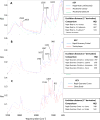Comprehensive chemical characterization of Rapé tobacco products: Nicotine, un-ionized nicotine, tobacco-specific N'-nitrosamines, polycyclic aromatic hydrocarbons, and flavor constituents
- PMID: 25934468
- PMCID: PMC5704902
- DOI: 10.1016/j.fct.2015.04.016
Comprehensive chemical characterization of Rapé tobacco products: Nicotine, un-ionized nicotine, tobacco-specific N'-nitrosamines, polycyclic aromatic hydrocarbons, and flavor constituents
Abstract
Rapé, a diverse group of smokeless tobacco products indigenous to South America, is generally used as a nasal snuff and contains substantial amount of plant material with or without tobacco. Previously uncharacterized, rapé contains addictive and harmful chemicals that may have public health implications for users. Here we report % moisture, pH, and the levels of total nicotine, un-ionized nicotine, flavor-related compounds, tobacco-specific N-nitrosamines (TSNAs) and polycyclic aromatic hydrocarbons (PAHs) for manufactured and hand-made rapé. Most rapé products were mildly acidic (pH 5.17-6.23) with total nicotine ranging from 6.32 to 47.6 milligram per gram of sample (mg/g). Calculated un-ionized nicotine ranged from 0.03 to 18.5 mg/g with the highest values associated with hand-made rapés (pH 9.75-10.2), which contain alkaline ashes. In tobacco-containing rapés, minor alkaloid levels and Fourier transform infrared spectra were used to confirm the presence of Nicotiana rustica, a high nicotine tobacco species. There was a wide concentration range of TSNAs and PAHs among the rapés analyzed. Several TSNAs and PAHs identified in the products are known or probable carcinogens according to the International Agency for Research on Cancer. Milligram quantities of some non-tobacco constituents, such as camphor, coumarin, and eugenol, warrant additional evaluation.
Keywords: Flavors; Nasal snuff; Nicotine; Rapé; Smokeless tobacco; Tobacco-specific nitrosamines.
Published by Elsevier Ltd.
Figures




Similar articles
-
Surveillance of moist snuff: total nicotine, moisture, pH, un-ionized nicotine, and tobacco-specific nitrosamines.Nicotine Tob Res. 2008 Nov;10(11):1645-52. doi: 10.1080/14622200802412937. Nicotine Tob Res. 2008. PMID: 18988077
-
Chemical analysis of Alaskan Iq'mik smokeless tobacco.Nicotine Tob Res. 2013 Jul;15(7):1283-8. doi: 10.1093/ntr/nts270. Epub 2013 Jan 3. Nicotine Tob Res. 2013. PMID: 23288872 Free PMC article.
-
Chemical and toxicological characteristics of conventional and low-TSNA moist snuff tobacco products.Toxicol Lett. 2016 Mar 14;245:68-77. doi: 10.1016/j.toxlet.2016.01.012. Epub 2016 Jan 21. Toxicol Lett. 2016. PMID: 26802282 Free PMC article.
-
The Swedish snus and the Sudanese toombak: are they different?Oral Oncol. 1998 Nov;34(6):558-66. doi: 10.1016/s1368-8375(98)00047-5. Oral Oncol. 1998. PMID: 9930371 Review.
-
A review of the analysis of tobacco-specific nitrosamines in biological matrices.Crit Rev Toxicol. 2010 Apr;40(4):305-27. doi: 10.3109/10408440903394435. Crit Rev Toxicol. 2010. PMID: 20210694 Review.
Cited by
-
Analysis of coumarin and angelica lactones in smokeless tobacco products.Chem Cent J. 2018 Dec 20;12(1):142. doi: 10.1186/s13065-018-0506-2. Chem Cent J. 2018. PMID: 30569337 Free PMC article.
-
The ultra-structural, metabolomic and metagenomic characterisation of the sudanese smokeless tobacco 'Toombak'.Toxicol Rep. 2021 Aug 5;8:1498-1512. doi: 10.1016/j.toxrep.2021.07.008. eCollection 2021. Toxicol Rep. 2021. PMID: 34401360 Free PMC article.
-
Regulation of toxic contents of smokeless tobacco products.Indian J Med Res. 2018 Jul;148(1):14-24. doi: 10.4103/ijmr.IJMR_2025_17. Indian J Med Res. 2018. PMID: 30264750 Free PMC article. Review.
-
Development of comprehensive data repository on chemicals present in smokeless tobacco products: Opportunities & challenges.Indian J Med Res. 2018 Jul;148(1):4-6. doi: 10.4103/ijmr.IJMR_108_18. Indian J Med Res. 2018. PMID: 30264748 Free PMC article. No abstract available.
-
Possible Association of Smokeless Tobacco Dependent Impairment in the Erythrocytes and Platelets Membranes of Human Male Volunteers: An Observation.Asian Pac J Cancer Prev. 2019 Jul 1;20(7):2167-2176. doi: 10.31557/APJCP.2019.20.7.2167. Asian Pac J Cancer Prev. 2019. PMID: 31350981 Free PMC article.
References
-
- Cardoso CM, Nascimento S. Etnobotany and Umbanda temples. College of Theology Umbanda. São Paulo, Brazil: 2008. p. 133. [translation]
-
- Cultivo de tabaco (translation: Tobacco Cultivation) Accessed on December 12, 2014 at http://cultivodetabaco.com/comunidad/temas/rape-nunu.392/
-
- Duke’s Phytochemical and Ethnobotanical Databases. Online Database access on December 12, 2014 at http://www.ars-grin.gov/duke/
-
- Duke JA, Vasquez R. Amazonian Ethnobotanical Dictionary. CRC Press; 1994. p. 224.
MeSH terms
Substances
Grants and funding
LinkOut - more resources
Full Text Sources
Other Literature Sources
Medical

